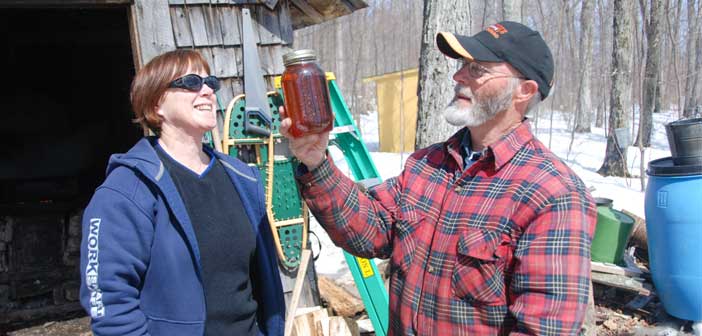SHEGUIANDAH—On a beautiful spring day last Friday that featured warm temperatures, little wind off nearby Bass Lake and following a chilly night, the conditions should have been close to perfect for a good run of sap at the Cannard family sugar bush in Sheguiandah, but the taps were a little slow off the start.
The Cannard property was purchased by the late Glen Cannard and his wife Jean in the 1960s, but the family believes the sugar shack and its implements were there since the 1940s—and nothing has changed since those days. Glena Roy and her brother Blaine Cannard pointed to the firebox upon which the evaporator sits inside the smoky sugar shack, which is on a definite lean.
That day, the bush was also host to New Zealanders Joanna Murchison and James Knight, who are currently living in London, England. Ms. Murchison is the niece of Mike Easton, Ms. Roy’s partner.
The kiwi couple had a day of firsts—eating camping snacks s’mores and tapping maple trees in typical Canadian fashion—much to their delight.
While maple flavour is easily found in London these days, the real deal is harder, and more expensive, to come by, Ms. Murchison explained.
Starting at the beginning of last week, Ms. Roy and her brother tapped and boiled most of the week, ending on Saturday with 26 litres. The siblings are hoping the weather will be more cooperative this week and are keeping their eye on Thursday as a potential date that the sap will again start to run into their 85 buckets.
The property features an equally old tractor with a rain barrel attached to the back that is used, when the snow isn’t very deep, to help collect the sap. Otherwise the sap is ‘hand bombed,’ being careful not to spill the precious liquid.
“In a day that we boil, we put enough sap in it so it’s at least an inch deep in the evaporator pan at the one end because it’s not really level (this is where the lean comes into play),” Ms. Roy explained. A small barrel on the right side of the shack allows the family to add sap to it once the boil is on. The barrel is rigged so that a trickle flow of sap is added gradually into the boil.
The boiled sap is moved from the larger evaporator pan to a smaller one until it passes the sheeting test. Ms. Roy explained the sheeting test as pouring the syrup “until the drips almost break off” from the metal dipper. A thermometer is also kept on hand for the final check too.
The syrup is then moved to an old creamer with a felt lining where a tap at the bottom releases the delicious amber into sterilized mason jars.
This, Ms. Roy said, will likely be the last year for the old sugar shack as the current system of pouring hot sap from one evaporator pan to a smaller one is dangerous. “And now that dad’s not here to look after us,” Ms. Roy chuckled.
When Mr. Cannard passed away, the family knew they had no intention of selling the sugar bush lot that holds so many fond memories. Ms. Roy spoke of many a spring night she and her father would leave the sugar shack after a day’s worth of boiling by the light of the moon.
While this may be the shack’s last season, it will still stand in testament to over 50 years of memories to the Cannard family. Ms. Roy explained that the family, via telephone family conference, has decided that an evaporator is the way to go for the future of their small operation and for future generations.
“Everybody just loves it,” Ms. Roy said of time spent in the bush. “And of course wiener roasts and making s’mores is all part of the fun too.”




















